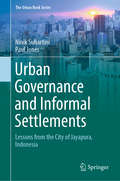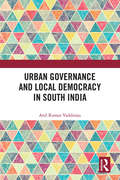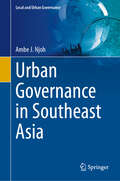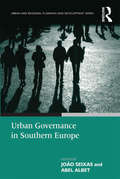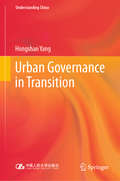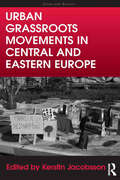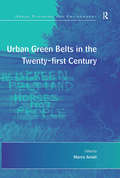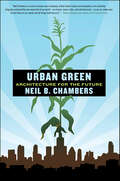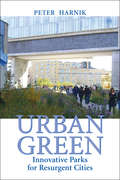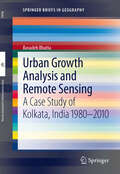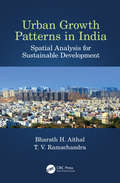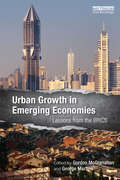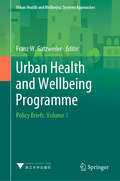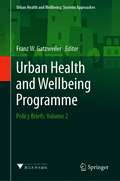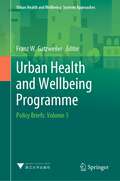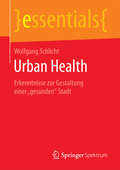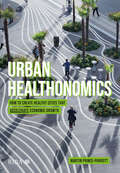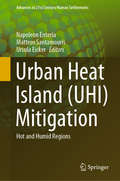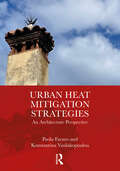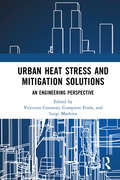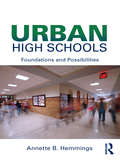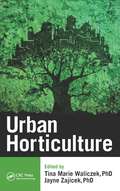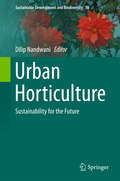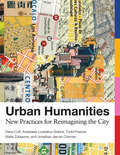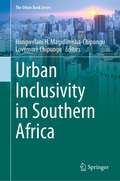- Table View
- List View
Urban Governance and Informal Settlements: Lessons from the City of Jayapura, Indonesia (The Urban Book Series)
by Paul Jones Ninik SuhartiniThe objective of this book is to better understand the nature of urban governance regarding the provision of basic urban services in rapidly growing mid-sized towns and cities in developing countries. Set within the context of understanding urban planning and management within the wider city setting, the study focuses on the provision of the basic urban services of housing, water and sanitation especially within informal settlements. Using the case study of the mid-sized city of Jayapura, Papua, Indonesia, the publication explores: (i) the types, processes, and stakeholders that constitute formal urban governance in the provision of basic urban services; (ii) understanding how stakeholders gain and benefit from ‘on the ground’ formal service arrangements, and why; and (iii) for those who do not directly benefit from the formal arrangements, how individuals, groups and communities organize and access governance to meet their basic urban needs. The methods employed to better understand the nature of urban governance and its relationship to the provision of basic urban services comprised primary (face-to-face household surveys interviewing 448 respondents, ground mapping at a plot size level in four informal settlements, and semi-structured interviews with 12 stakeholders) and secondary data regarding urban governance, planning and management. The study reveals that urban governance arrangements in fast growing mid-sized cities have emerged both formally and informally to cope with basic urban service needs across a range of settlement types and socio-cultural groups. The major modes of governance arrangements in the informal settlements consist of traditional, formal and informal, and hybrid governance which co-evolve as their boundaries overlap and intersect through time at varying levels of ‘equilibrium’. The ‘governance equilibrium’ represents a ‘balance’ at a specific point and place in time in how stakeholders utilize and share resources, and access various contributions.
Urban Governance and Local Democracy in South India
by Anil Kumar VaddirajuThis book examines the issues of urban governance and local democracy in South India. It is the first comprehensive volume that offers comparative frameworks on urban governance across all states in the region: Karnataka, Andhra Pradesh, Telangana, Tamil Nadu and Kerala. The book focuses on governance in small district-level cities and raises crucial questions such as the nature of urban planning, major outstanding issues for urban local governance, conditions of civic amenities such as drinking water and sanitation and problems of social capital in making urban governance work in these states. It emphasizes on both efficient urban governance and effective local democracy to meet the challenges of fast-paced urbanization in these states while presenting policy lessons from their urbanization processes. Rich in empirical data, this book will be useful to scholars and researchers of political studies, public administration, governance, public policy, development studies and urban studies, as well as practitioners and non-governmental organizations.
Urban Governance in Southeast Asia (Local and Urban Governance)
by Ambe J. NjohThe book draws from regulation theory to explain urban planning policies and outcomes in Southeast Asia as a function of governance structures and processes. A considerable portion of the book is spent re-tracing the historical roots of planning dispositives, including the totality of institutional entities, which together constitute an apparatus of government in South-East Asian polities. Therefore, of essence in the book are the institutional structures and administrative principles, that were introduced by colonial authorities and inherited by their post-colonial successors in South-East Asia. The book seeks to demonstrate the role of the policies and commensurate implementation institutional frameworks in accounting for important dynamics in the contemporary urban domain in the region. In analyzing the institutional framework for urban planning and governance, the book is doing due diligence to a hitherto neglected subject, namely governmentality, in the discourse on the political economy of urban management in Southeast Asia. Thus, the book is intended to acknowledge the importance of institutions in determining the success of urban development policies. The notion of institutions or governmentality as will be used in the book includes, de facto governance structures, government and parastatal agencies and the formal rules and regulations they are charged with implementing. The book is based on the premise that knowledge of institutions and their functions is critical in explaining phenomena in economic geography. This is particularly true in Southeast Asian countries because of the dominant and overarching role of the state or government agencies in the economy.
Urban Governance in Southern Europe (Urban And Regional Planning And Development Ser.)
by Abel AlbetThe concept of governance has evolved into one of the most important but also controversial concepts in urban politics. While it encourages co-operation, participation and collective construction, at the same time, it has brought about new forms of public demission, oligarchic regimes and less local democracy. The dilemmas accompanying these changes are particularly relevant when observing the cities of Southern Europe, whose socio-cultural specificities very much structure local political and policy materialisations. Bringing together a team of leading scholars from across the social sciences, this volume examines the issues of urban governance in the Southern European context. Illustrated by case studies of several main cities and metropoles on the North Mediterranean coast, it introduces and critically analyses the latest theories and approaches to urban governance. It questions how the 'real' or socio-cultural notion of city seems to have been separated from that of the 'political' city and explores how more integrated socio-political forms might be developed. It looks at current structures, dynamics and cultures of governance in urban development and questions whether they are well adapted to new realities and challenges or whether there are significant imbalances causing limited or fragmented political-administrative visions. By considering both the long Mediterranean history along with the recent but enduring global economic and political developments, this book argues that Southern European cities will have to depend greatly upon its own socio-cultural networks, dynamics and cosmopolitan evolution, making the most of the region's characteristic urban strengths, as trading hubs, with rich hinterlands and large and varied population.
Urban Governance in Transition (Understanding China)
by Hongshan YangThis book offers readers a comprehensive introduction to the functions of the government in contemporary China. Further, it creates a framework to describe urban governance in today’s China, which consists of four basic modes: the omnipotent government mode, autonomous governance mode, integrated governance mode and cooperative governance mode. The book defines a “city” as a gathering place for high-quality public service resources, and the basic task of urban governance is to provide high-quality public services and maintain the sustainability of fiscal revenues. By focusing on current “hot topics” in urban governance in China, including the institutional development of urban governance, model interpretation, city/county relationship, cross-border governance, cross-sectoral coordination, street management, community service provision, and municipal performance evaluation, it clarifies a number of common misunderstandings in the field of urban management and practice. Lastly, the book analyses the current integrated governance model used in Chinese cities, which relies on the authority of the government and integrates the market and social subjects across borders by means of qualification identification, resource support, elite absorption, party-group embeddedness, and project cooperation. However, this model is currently facing several problems. In order to address the potential risks of integrated governance, the book argues that we need to develop new institutional arrangements based on collaborative governance.
Urban Grassroots Movements in Central and Eastern Europe (Cities and Society)
by Kerstin JacobssonWhat can we learn about collective action across Central and Eastern Europe by focusing on activism within urban spaces? This volume argues that the recent resurgence of urban grassroots mobilisation represents a new phase in the development of post-socialist civil societies and that these civil societies have significantly more vitality than is commonly perceived. The case studies here reflect the diversity and complexity of post-socialist urban movements, capturing also the extent to which the laboratory of urban politics is richly illustrative of the complex nexus of state-society-market relations within post-socialism. The grassroots campaigns and actions reflect the new social cleavages and increased polarisation as a consequence of neoliberal urbanisation and global integration, as well as the transformation of state power and authority in the region. Studying urban activism in Central and Eastern Europe is instructive for urban movements scholars generally, as it forces us to acknowledge the variety of forms that contention can take and the usefulness of embedding the study of urban movements within a larger understanding of civil society.
Urban Green Belts in the Twenty-first Century
by Marco AmatiPlanners internationally have employed green belts to contain the explosive sprawl of cities as varied as Tokyo, Vienna and Melbourne during the twentieth century. As yet, no collection has gathered these experiences together to consider their contribution to planning. Juxtaposing examples of green belt implementation worldwide, this book adds to understanding of how green belts can be effected in theory and how practitioners have adapted them in practice. The book provides a typology of green belt implementation and reform, enabling planners to grasp why these policies are employed and whether they are relevant to twenty-first century planning.
Urban Green: Architecture for the Future
by Neil B. ChambersSustainable design is booming, but the men and women dedicated to reducing their carbon impact have lost sight of what they are trying to save: the natural world. Author Neil Chambers has been at the forefront of cutting-edge, sustainable architecture for years, and Urban Green is his revolutionary vision for bringing the power of the conservation and design movements together. He advocates looking to nature for the missing components of the green revolution: oysters that can clean water at up to 5 liters an hour; beavers that reshape their environments while simultaneously enriching ecosystems; and mountains that offer a new way of imagining how a city could be built. By designing our homes and cities in harmony with the natural world, we can take the next step in the sustainable revolution.
Urban Green: Innovative Parks for Resurgent Cities
by Peter Harnik Mayor Michael BloombergFor years American urban parks fell into decay due to disinvestment, but as cities began to rebound--and evidence of the economic, cultural, and health benefits of parks grew-- investment in urban parks swelled. The U.S. Conference of Mayors recently cited meeting the growing demand for parks and open space as one of the biggest challenges for urban leaders today. It is now widely agreed that the U.S. needs an ambitious and creative plan to increase urban parklands. Urban Green explores new and innovative ways for "built out" cities to add much-needed parks. Peter Harnik first explores the question of why urban parkland is needed and then looks at ways to determine how much is possible and where park investment should go. When presenting the ideas and examples for parkland, he also recommends political practices that help create parks. The book offers many practical solutions, from reusing the land under defunct factories to sharing schoolyards, from building trails on abandoned tracks to planting community gardens, from decking parks over highways to allowing more activities in cemeteries, from eliminating parking lots to uncovering buried streams, and more. No strategy alone is perfect, and each has its own set of realities. But collectively they suggest a path toward making modern cities more beautiful, more sociable, more fun, more ecologically sound, and more successful.
Urban Growth Analysis and Remote Sensing
by Basudeb BhattaThis book documents research conducted on the analysis of urban growth and sprawl by using remote sensing data and GIS techniques. The research was conducted between 1980-2010 in the city of Kolkata, India. The aim of the research was to use metrics that were less demanding in terms of data and computation than normal metrics. However, it has been found that most of them were inferior in capturing insights of urban sprawl. For this book, some of these metrics have therefore been modified and new ones are proposed. The research focuses on problems associated with the analysis of urban growth by using remote sensing data from a technological perspective.
Urban Growth Patterns in India: Spatial Analysis for Sustainable Development
by Bharath H. Aithal T. V. RamachandraThis book uses spatio-temporal analysis to understand urbanisation in Indian cities and explain the concept and impact of global greenhouse gas (GHG) emissions. It creates a GHG footprint for Indian cities and engages in a discussion about the United Nations Sustainable Development Goals (SDGs) and smart city initiatives within an Indian context. Understanding the spatial patterns of land use/land cover (LULC) dynamics in the rapidly urbanising cities of India, the readers will be able to simulate future urbanisation patterns and use spatial temporal analysis as a tool for implementing appropriate mitigation measures. Features Analyses the complete urbanisation and urban sprawl of major cities in India using advanced geospatial modelling techniques Highlights the best practices and methods used in modelling urban growth Discusses greenhouse gas emissions from various sectors and their effects in local environments Addresses the increase of local temperature in cities due to unplanned land use change and its impact on environmental sustainability and resilience Fills the need for data-driven governance and policy decisions by introducing various analyses through spatial mapping Highlighting some of the best practices and tools being used for modelling urban growth through case studies, the book is useful to those interested in using new technologies and methods for data collection and problem solving. It focuses on the major environmental issues in India, which are prevalent in most developing countries.
Urban Growth in Emerging Economies: Lessons from the BRICS
by George Martine Gordon McGranahanAlong with globalization, urban transitions have been central in the southward shift in economic power towards the newly emerging economies. As this book shows, however, these transitions have not been painless, and it is important for the rest of the urbanizing world to learn from the mistakes. It examines the role of urbanization and urban growth in the emerging economies, taking the BRICS countries (Brazil, Russia, India, China and South Africa) as case studies. Their different approaches towards urbanization have shaped their historical development paths and assisted or constrained their futures. Several of the BRICS bear heavy burdens from past failures to accommodate urban growth inclusively and efficiently, and many other urbanizing countries in Asia and Africa are in danger of replicating their mistakes. The overriding lesson of the book is that cities and nations must anticipate urbanization, and accommodate urban growth pro-actively, so as not to be left with an enduring legacy of inequalities and lost opportunities. This book is aimed at students and researchers in urban studies and development studies. It will also be of interest to policy advisors concerned with urbanization and the role of cities in a country’s development
Urban Health and Wellbeing Programme: Policy Briefs: Volume 1 (Urban Health and Wellbeing)
by Franz W. GatzweilerThis book is a compilation of the policy briefs produced by the International Science Council’s program on Urban Health and Wellbeing: A Systems Approach over the past five years. Intended for urban decision-makers at all levels, it highlights policy-relevant findings and research insights to encourage the co-creation of knowledge for healthy urban environments and people. The book shows how variations on the systems approach developed and promoted by the program have been implemented in regions around the world and contributed to improving urban health. These policy briefs summarize research findings and scientific events concerning urban health-related topics that are relevant for public health professionals, urban planners, urban stakeholder groups and the public at large.
Urban Health and Wellbeing Programme: Policy Briefs: Volume 2 (Urban Health and Wellbeing)
by Franz W. GatzweilerThis book is a collection of policy briefs produced from research presented at the 16th Conference on Urban Health in Xiamen, China, November 4–8, 2019, under the theme “People Oriented Urbanisation: Transforming Cities for Health and Well-Being”, co-organized by the Urban Health and Wellbeing (UHWB) programme of the International Science Council (ISC). The UHWB programme takes an interdisciplinary, cross-sectoral and systemic view on issues of health and wellbeing in cities which include the urban economy and finance systems, education, employment, mobility and transport, food, energy and water resources, access to public services, urban planning, public spaces and urban green, as well as social inclusion. Contributions to this book have been made by scientists from multidisciplinary research fields. The policy briefs in this book present the background and context of an urban health issue, research findings and recommendations for policy/decision-makers and action-takers. In some cases, they inform about relevant events and developments from the science community or important opinion pieces which address health emergencies, like the current COVID-19 pandemic. The book is intended for citizens and political decision-makers, who are interested in systems perspectives on urban health and wellbeing, examples of how to deal with the increasing complexity of cities and the accompanying environmental and social impacts of increasing urbanization. Furthermore, it hopes to inspire decision-makers to facilitate finding solutions, in order to reach the goal of advancing global urban health and wellbeing.
Urban Health and Wellbeing Programme: Policy Briefs: Volume 3 (Urban Health and Wellbeing)
by Franz W. GatzweilerThis book presents the background and context of an urban health issue, research findings, and recommendations for policy/decision-makers and action-takers. This book is a collection of policy briefs produced from research presented at the 16th Conference on Urban Health in Xiamen, China, during November 4–8, 2019, under the theme “People Oriented Urbanisation: Transforming Cities for Health and Well-Being,” co-organized by the Urban Health and Wellbeing (UHWB) programme of the International Science Council (ISC), The 15th Annual Session of Global Forum on Human Settlements in Shenzhen, China, during October 15–16, 2020, and the Chinese Academy of Sciences & Technology (CAST) International Conference on "Digital economy and green development" held during November 2020. The UHWB programme takes an interdisciplinary, cross-sectoral, and systemic view on issues of health and well-being in cities which include the urban economy and finance systems, education, employment, mobility and transport, food, energy and water resources, access to public services, urban planning, public spaces and urban green, as well as social inclusion. Contributions to this book have been made by scientists from multidisciplinary research fields. The policy briefs in this book provide an interdisciplinary and cross-sectoral perspective on urban health and human well-being issues, primarily food security, urban infrastructure, public services, traffic and transportation, smart city building, urban health and safety, social cohesion sustainable development policies, and urban planning. In some case, it informs about urban health issues in different regions of the world, the current status, and key insights into addressing related issues, with emphasis on factual cases in the current COVID-19 pandemic. The book is intended for citizens and political decision-makers, who are interested in systems perspectives on urban health and well-being, examples of how to deal with the increasing complexity of cities and the accompanying environmental and social impacts of increasing urbanization. Furthermore, it hopes to inspire decision-makers to facilitate finding solutions, in order to reach the goal of advancing global urban health and well-being.
Urban Health: Erkenntnisse zur Gestaltung einer „gesunden“ Stadt (essentials)
by Wolfgang SchlichtWolfgang Schlicht stellt das Forschungsgebiet Urban Health, im Deutschen auch StadtGesundheit, vor, in dem er zu Beginn einen kurzen Abriss zur Geschichte der Stadt, zu Leitbildern der Stadtgestaltung und zu Urban Health gibt. Ausgew#65533;hlte Erkenntnisse zu Stadtmerkmalen, die Gesundheit beeintr#65533;chtigen (reaktions-orientierte Perspektive), und zu solchen, die Gesundheit f#65533;rdern (promotions-orientierte Perspektive), werden referiert. Theoretische Konzepte und methodische #65533;berlegungen zur Erkenntnisgewinnung runden das essential ab.
Urban Healthonomics: How to create healthy cities that accelerate economic growth
by Martin Prince-ParrottHow can we design cities that radically improve our health and accelerate economic growth?The need for bold solutions and innovative commercial strategies has never been greater. Cities face mounting, converging challenges: climate change, economic recovery, spiralling debt and ageing populations.To address these issues, urban leaders must find ways to reduce operational and healthcare costs, stimulate economic growth and attract investment, all while ensuring cities remain vibrant and desirable places to live and raise families.Healthy cities supported by sustainable buildings and resilient infrastructure are the most effective and cost-efficient safeguard against urban decline. This book provides a compelling, data-driven roadmap for urban stakeholders, showing how to boost public health, cut costs and drive economic growth.Each chapter breaks down the biological, economic and societal impacts of urban challenges, complete with practical, actionable solutions rooted in real-world case studies and detailed research.This is a must-read for designers, developers, residents, policymakers, founders, and anyone passionate about shaping the future of our cities.
Urban Heat Island: Hot and Humid Regions (Advances in 21st Century Human Settlements)
by Ursula Eicker Napoleon Enteria Matteos SantamourisThis book discusses the concepts and technologies associated with the mitigation of urban heat islands (UHIs) that are applicable in hot and humid regions. It presents several city case studies on how UHIs can be reduced in various areas to provide readers, researchers, and policymakers with insights into the concepts and technologies that should be considered when planning and constructing urban centres and buildings. The rapid development of urban areas in hot and humid regions has led to an increase in urban temperatures, a decrease in ventilation in buildings, and a transformation of the once green outdoor environment into areas full of solar-energy-absorbing concrete and asphalt. This situation has increased the discomfort of people living in these areas regardless of whether they occupy concrete structures. This is because indoor and outdoor air quality have both suffered from urbanisation. The development of urban areas has also increased energy consumption so that the occupants of buildings can enjoy indoor thermal comfort and air quality that they need via air conditioning systems. This book offers solutions to the recent increase in the number of heat islands in hot and humid regions.
Urban Heat Mitigation Strategies: An Architecture Perspective
by Paola Favaro Konstantina VasilakopoulouUrban Heat Mitigation Strategies: An Architecture Perspective explores heat mitigation strategies integrated into the urban architecture of global cities, aiming to enhance citizens’ quality of life through thoughtful design decisions blending architecture, science and engineering. The projects examined exemplify top-tier approaches in architecture, urban planning, landscape design and engineering across diverse city precincts worldwide. Inspired by architect and urban designer Lewis Mumford’s 1970s call for urban spaces that support citizens, these initiatives focus not just on aesthetics but also on effective social and climate change mitigation strategies.Featuring international urban projects recognised for both architectural significance and improved thermal comfort, this book examines the various heat mitigation strategies in major urban projects using architectural and engineering methodologies. Combining architectural formal/critical analysis with engineering performance modelling, the authors offer qualitative and quantitative assessments of each urban project. These projects showcase best practices utilising elements such as water, materials, vegetation and canopy to mitigate heat and promote civic life. Originally intended for aesthetics and social functionality, these strategies now serve as benchmarks for creating thermally comfortable public spaces globally.Relevant to architects, city planners, landscape designers and engineers, Urban Heat Mitigation Strategies: An Architecture Perspective promotes successful collaboration among built environment professionals to address climate concerns and create liveable, comfortable urban spaces.
Urban Heat Stress and Mitigation Solutions: An Engineering Perspective
by Vincenzo CostanzoThis book provides the reader with an understanding of the impact that different morphologies, construction materials and green coverage solutions have on the urban microclimate, thus affecting the comfort conditions of urban inhabitants and the energy needs of buildings in urban areas. The book covers the latest approaches to energy and outdoor comfort measurement and modelling on an urban scale, and describes possible measures and strategies to mitigate the effects of the mutual interaction between urban settlements and local microclimate. Despite its relevance, only limited literature is currently devoted to appraising—from an engineering perspective—the intertwining relationships between urban geometry and fabrics, energy fluxes between buildings and their surroundings, outdoor microclimate conditions and building energy demands in urban areas. This book fills this gap by first discussing the physical processes that govern heat and mass transfer at an urban scale, while emphasizing the role played by different spatial arrangements, manmade materials and green infrastructures on the outdoor microclimate. The first chapters also address the implications of these factors on the outdoor comfort conditions experienced by pedestrians, and on the buildings’ energy demand for space heating and cooling. Then, based upon cutting-edge experimental activities and simulation work, this book demonstrates current and forthcoming adaptation and mitigation strategies to improve the urban microclimate and its impact on the built environment, such as cool materials, thermochromic and retroreflective finishing materials, and green infrastructures applied either at a building scale or at the urban scale. The effect of these solutions is demonstrated for different cities worldwide under a range of climate conditions. Finally, the book opens a wider perspective by introducing the basic elements that allow fuel poverty, raw materials consumption, and the principles of circular economy in the definition of a resilient urban settlement.
Urban High Schools: Foundations and Possibilities (Sociocultural, Political, and Historical Studies in Education)
by Annette B. HemmingsThis multidisciplinary overview introduces readers to the historical, sociological, anthropological, and political foundations of urban public secondary schooling and to possibilities for reform. Focused on critical and problematic elements, the text provides a comprehensive description and analyses of urban public high schooling through different yet intertwined disciplinary lenses. Students and researchers seeking to inform their work with urban high schools from social, cultural, and political perspectives will find the theoretical frameworks and practical applications useful in their own studies of, or initiatives related to, urban public high schools. Each chapter includes concept boxes with synopses of key ideas, summations, and discussion questions.
Urban Horticulture
by Tina Marie Waliczek Jayne M. ZajicekIn the wake of urbanization and technological advances, public green spaces within cities are disappearing and people are spending more time with electronic devices than with nature. Urban Horticulture explores the importance of horticulture to the lives, health, and well-being of urban populations. It includes contributions from experts in researc
Urban Horticulture: Sustainability For The Future (Sustainable Development and Biodiversity #18)
by Dilip NandwaniThis book provides comprehensive information on the rapidly developing field of urban horticulture for sustainable use of land resources and creating a better environment. It presents peer-reviewed chapters from leading international researchers in the field of horticulture technologies, environmental issues, urban horticulture, and landscaping and its role in society. It covers a wide array of topics on this subject and constitutes a valuable reference guide for students, professors, researchers, builders, and agriculturists concerned with urban horticulture, city planning, biodiversity, and the sustainable development of horticultural resources. Urban horticultural technologies facilitate the efficient use of available land in urban and residential areas, helping meet the demand for fresh fruits and vegetables to feed ever-growing urban populations. The amount of green space in urban areas is dwindling due to rising land prices, while the climbing numbers of multi-story buildings are producing various environmental and health issues. Technological advances provide tools and techniques for high-density and vertical cropping in small areas, promoting efficient and sustainable resource utilization. As such, urban horticulture is gaining importance in city planning – not only to bolster the food supply but also to improve the aesthetic value, environmental conditions, landscape, and business environment, while also reducing the consumption of fossil fuel in transportation.
Urban Humanities: New Practices for Reimagining the City (Urban and Industrial Environments)
by Todd Presner Dana Cuff Anastasia Loukaitou-Sideris Maite Zubiaurre Jonathan Jae-An CrismanOriginal, action-oriented humanist practices for interpreting and intervening in the city: a new methodology at the intersection of the humanities, design, and urban studies.Urban humanities is an emerging field at the intersection of the humanities, urban planning, and design. It offers a new approach not only for understanding cities in a global context but for intervening in them, interpreting their histories, engaging with them in the present, and speculating about their futures. This book introduces both the theory and practice of urban humanities, tracing the evolution of the concept, presenting methods and practices with a wide range of research applications, describing changes in teaching and curricula, and offering case studies of urban humanities practices in the field.Urban humanities views the city through a lens of spatial justice, and its inquiries are centered on the microsettings of everyday life. The book's case studies report on real-world projects in mega-cities in the Pacific Rim—Tokyo, Shanghai, Mexico City, and Los Angeles—with several projects described in detail, including playful spaces for children in car-oriented Mexico City, a commons in a Tokyo neighborhood, and a rolling story-telling box to promote “literary justice” in Los Angeles.
Urban Inclusivity in Southern Africa (The Urban Book Series)
by Lovemore Chipungu Hangwelani H. Magidimisha-ChipunguThis book’s point of departure rests on the premises that dimensions of the mainstream inclusive city discourse fail to capture in detail vulnerable clusters of society (being women, children, and the aging), the minority clusters (i.e., the blind, the disabled), and migrants. In addition, it fails to recognize the increase of spatial inequality driven by racial and class differences—a factor that has seen an increase in community violence and protests. The focus on spatial inequality has, for a long time, blind-folded urban authorities to ignore exclusion arising out of the same environments created with a notion of creating inclusivity. Hence this book “collapses spatial walls” as it seeks to uncover the true perspectives of inclusivity in cities beyond spatial dimensions but within social realms. The depth of this book’s enquiry rests on its critical investigation of Southern African cities’ through historical epochs of apartheid and colonialism in the region.
